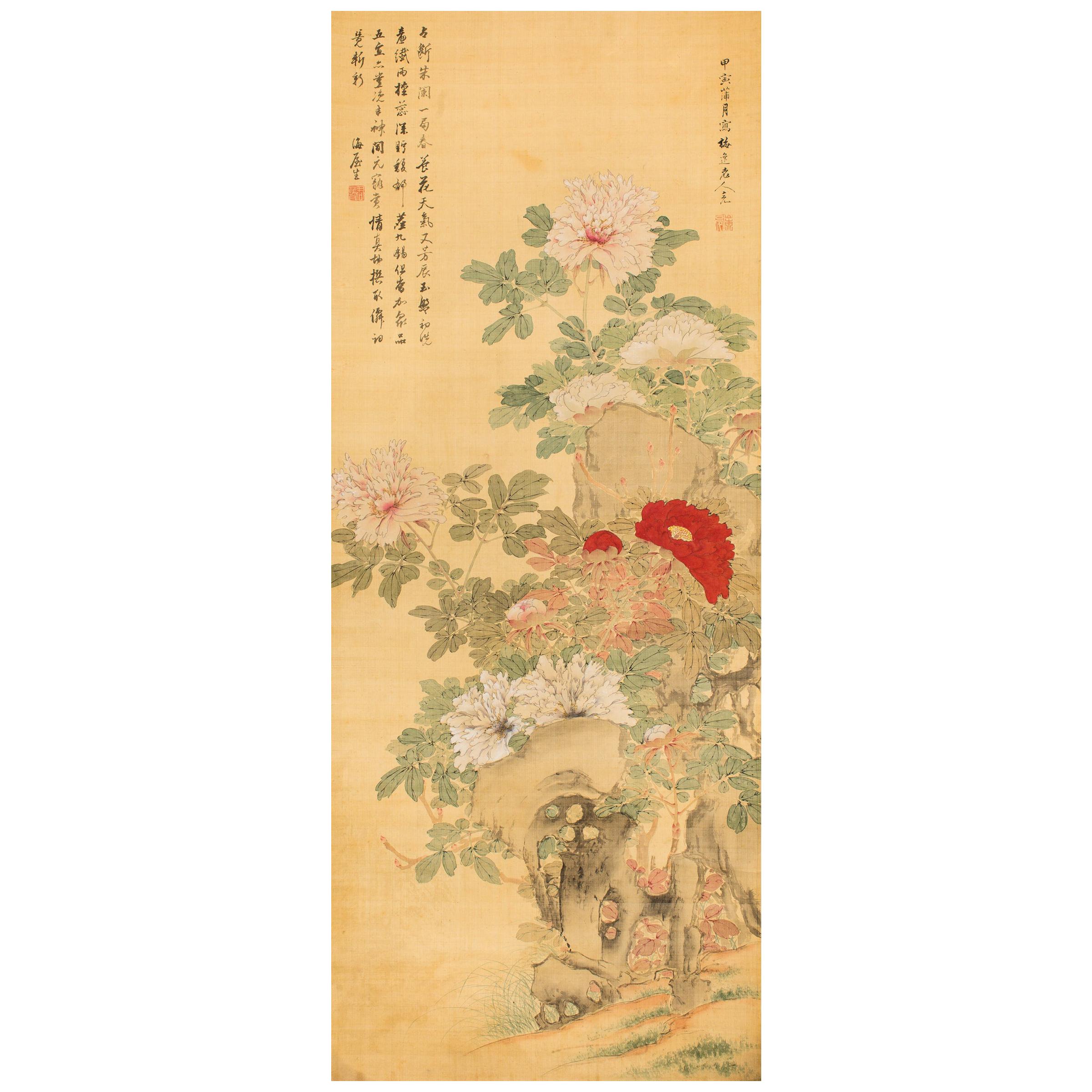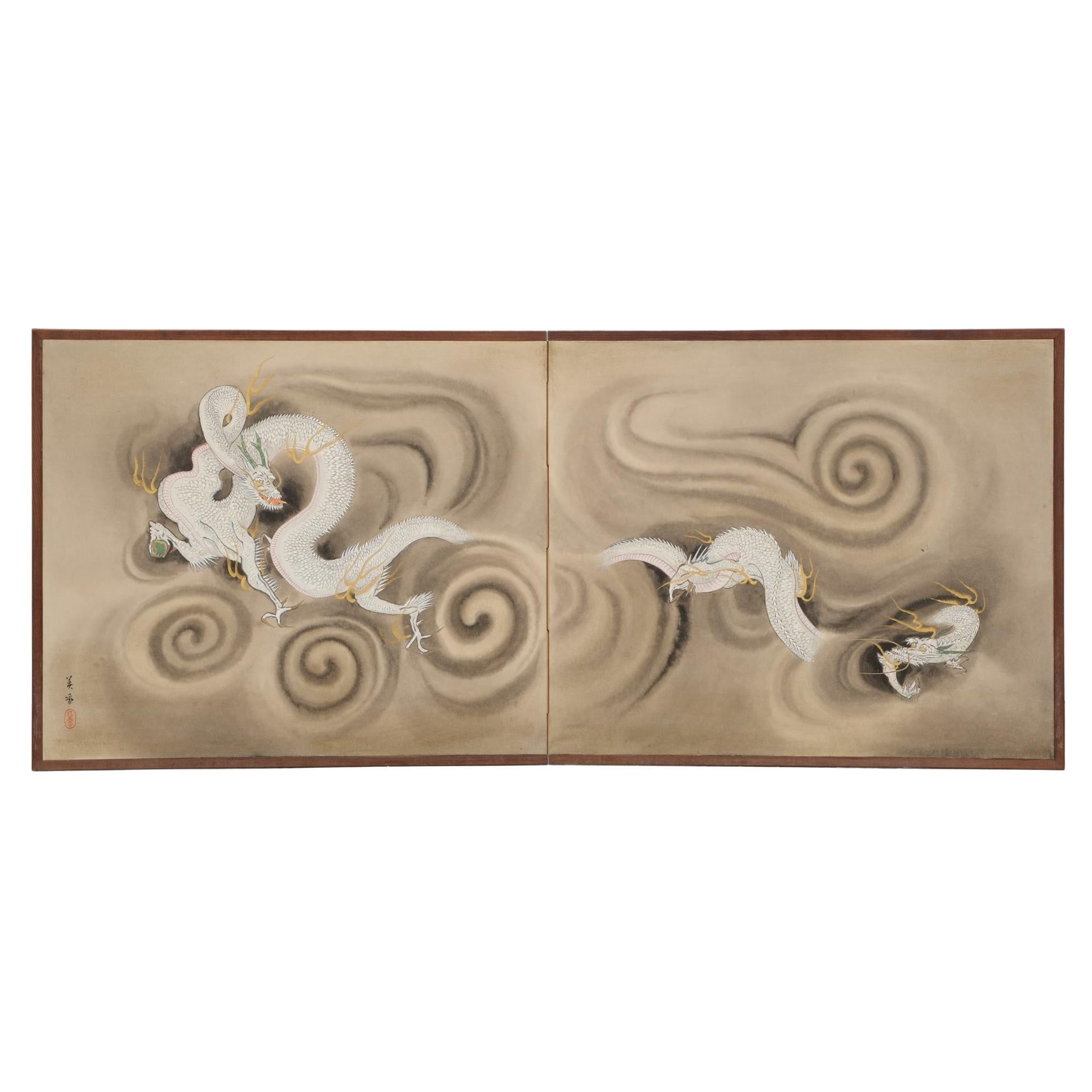Items Similar to Japan Antique Tea Master Ceremony Guide Double Scroll Matsudara Fumai 1751-1818
Want more images or videos?
Request additional images or videos from the seller
1 of 15
Japan Antique Tea Master Ceremony Guide Double Scroll Matsudara Fumai 1751-1818
About the Item
From our most recent Japanese acquisitions
Rare Hand-Painted Double Tea Master Scroll (2) entitled: Tea Ceremony Rules of Matsudaira Fumai (1751-1818)
Includes a later wooden collector box tomobako.
Artist/Creator:
MATSUDAIRA HARUSATO (1751-1818). He was a daimyo who ruled the Matsue Domain. He was renowned as a tea master, under the name Matsudaira Fumai.
Signature (Seal): Unknown
Large Scroll: 8 inches high and 160 inches length
Small Scroll: 7.5 inches high and 115 inches length
Origin: Japan
Material: Paper
Roller ends: Wood & Pottery
This is an antique Japanese Edo period chado (tea ceremony) double scroll hand written and hand painted . These scrolls contain vivid illustrations and lengthy calligraphy for rules and guidelines for a tea ceremony.
Both scrolls are hand made of the inner bark of the gampi (mulberry) tree to last virtually indefinitely. The scrolls were then hand affixed into traditional Japanese horizontal scroll forms.
A rare find. The hand writing is block style kanji common to the cultural elite of that day. The mulberry washi paper was made of the inner bark of the gampi (mulberry) tree to last virtually indefinitely.
Despite their age, these calligraphy scrolls are still very clear having been lovingly cared for by its former collector.
Rare opportunity and extraordinary treasure find..
Age: Edo period.
Provenance: an old Japanese collection.
Lifetime guarantee of authenticity: All of our Asian works of art come with our lifetime authenticity guarantee.
- Dimensions:Height: 8 in (20.32 cm)Width: 160 in (406.4 cm)Depth: 0.5 in (1.27 cm)
- Style:Edo (Of the Period)
- Materials and Techniques:
- Place of Origin:
- Period:
- Date of Manufacture:19th Century
- Condition:Wear consistent with age and use.
- Seller Location:South Burlington, VT
- Reference Number:1stDibs: LU1289234093542
About the Seller
5.0
Platinum Seller
These expertly vetted sellers are 1stDibs' most experienced sellers and are rated highest by our customers.
Established in 1990
1stDibs seller since 2015
2,209 sales on 1stDibs
Typical response time: 1 hour
- ShippingRetrieving quote...Ships From: South Burlington, VT
- Return PolicyA return for this item may be initiated within 7 days of delivery.
More From This SellerView All
- Japanese Vintage Tea Ceremony Bronze Tea BellLocated in South Burlington, VTA one-of-a-kind rare tea ceremony accessory discovered from our recent Japanese acquisitions travels. Seldom seen and with lovely sound. This is an extraordinary opportunity to...Category
Early 20th Century Japanese Taisho Sculptures and Carvings
MaterialsBronze
- Japanese Old Tea Ceremony Pot Chagama "Trellice and Flowers" Immediately UsableLocated in South Burlington, VTFrom our recent Japanese acquisitions with original signed box. A finely cast Japanese traditional iron teapot -chagama- with a wonderful relief band and design of summer time bam...Category
Mid-20th Century Japanese Showa Scholar's Objects
MaterialsIron, Bronze
- China Natural Stone "Painting" Moonlight EarthLocated in South Burlington, VTChinese extraordinary natural stone painting "Moonlight Earth" #9 This Chinese extraordinary natural stone "painting" of what appears to be a blac...Category
Late 20th Century Chinese Mid-Century Modern Scholar's Objects
MaterialsMarble
- Japanese Rare Antique Scroll of Waka Heart Poem Famous Rengetsu Otagaki, signedLocated in South Burlington, VTJapan, a rare paper scroll hand painted by renown Rengetsu Otagaki (1791-1875). She was a very famous nun in old Japan and being familiar with poetry, her Waka poems on paper, and e...Category
Antique Late 19th Century Japanese Edo Paintings and Screens
MaterialsPaper
- Japanese Rare Antique Inlaid Smoking Tansu, Complete 1850Located in South Burlington, VTThe first we have seen A spectacular and hard to find Inlaid mother of pearly - using the raden technique- and lacquered three-drawer Tansu complete with all original bronze accoutrement including a fine engraved antique long pipe and two removable covered bronze cylinders all executed by expert mid-19th century Edo samurai...Category
Antique 19th Century Japanese Edo Scholar's Objects
MaterialsBronze
- Japanese Tea Bowl Flying Bats & Good Fortune Hand-Built Hand GlazedLocated in South Burlington, VTMint condition From Japan, a hard to find and unusual hand-built, painted and glazed tea bowl featuring "flying bats" - signs of good fortune, created over thirty years ago. A stunn...Category
Late 20th Century Japanese Showa Ceramics
MaterialsCeramic, Pottery
You May Also Like
- Antique Japanese Shino Ware Chawan Tea BowlLocated in Atlanta, GAOn offer is a Japanese ceramic tea bowl (chawan) used in the traditional chado ceremony. The bowl was potted in clog form with a ring foot shaved extremely low. Its size and harmonious proportion make it perfect to be held in both hands during chado. Classified as shino ware...Category
Antique 18th Century Japanese Edo Ceramics
MaterialsCeramic
- Antique Japanese Scroll of PeoniesLocated in Hudson, NYEdo period (first half of the 19th century) antique Japanese scroll of peonies. Signature and seal read: Baiitsu Yamamoto, (1783-1856). Yamamoto was t...Category
Antique 19th Century Japanese Edo Paintings and Screens
MaterialsWood, Paper
- 19th Century Japanese Screen for Tea-Ceremony, Ink Bamboo and Plum on Gold LeafLocated in Kyoto, JPThree Friends of Winter Nakajima Raisho (1796-1871) Late Edo period, circa 1850 Ink and gold leaf on paper. This is a double-sided Japanese Furosaki or tea-ceremony screen from the mid 19th century; bamboo and plum on the front, young pines the back. It by Nakajima Raisho, a master painter of the Maruyama school in the late Edo and early Meiji periods. In this work Raisho combines exquisite ink brushwork with large open spaces of brilliant gold-leaf to inspire the viewers imagination. Rather than naturalism, he is searching for the phycological impression of the motifs, resulting in abstraction and stylization. His simplification of the motifs the result of looking to capture the inner nature of the objects. This art motif is known as Sho Chiku Bai, or the Three Friends of Winter. Evergreen pine connotes steadfastness, bamboo suggests both strength and flexibility, while plum blossoms unfurling on snow-laden branches imply hardiness. Combined, this trio is emblematic of Japanese new year. Chinese literati were the first to group the three plants together due to their noble characteristics. Like these resilient plants flowering so beautifully in winter, it was expected of the scholar-gentleman to cultivate a strong character with which he would be able to show the same degree of perseverance and steadfastness even during times of adverse conditions. The screen would have been placed near the hearth of a room used for the Japanese tea ceremony, shielding the fire from draughts and also forming a stimulating and decorative backdrop behind the tea utensils. It would have been used in the Hatsugama, or first tea-ceremony of the new year. Nakajima Raisho (1796-1871) originally studied under Watanabe Nangaku before entering the school of Maruyama Ozui. He was the highest ranking Maruyama school painter at the end of the Edo period and was known as one of the ‘Four Heian Families’ along with Kishi...Category
Antique Mid-19th Century Japanese Edo Paintings and Screens
MaterialsGold Leaf
- Japanese 2-Panel Furosaki’byôbu 風炉先屏風 'Tea-Ceremony Folding Screen' with DragonsLocated in Amsterdam, NLA striking low and wide two-panel furosaki’byôbu (tea-ceremony room divider) painted with two bright white dragons (ryû) flying amidst swirling black clouds. The left dragon holds a ...Category
Early 20th Century Japanese Paintings and Screens
MaterialsWood, Paper
- Chinese Stone Dali PanelsLocated in Somerton, GBThis is a set of four antique Chinese Dali stone panels which depict wonderful landscape images. The stone is set in an ebonized panel frame. They look wo...Category
Antique Early 1900s Chinese Qing Scholar's Objects
MaterialsMarble, Brass
- Magnificent And Fine Chinese Six-Panel ScreenLocated in Bridgeport, CTA six panel screen in black paint with overall gilt scrolled and carved and painted wood applied low relief decoration with some Mother-of-Pearl details. Scenes with pavilions and fi...Category
Antique 19th Century Qing Paintings and Screens
MaterialsMother-of-Pearl, Wood, Lacquer
Recently Viewed
View AllMore Ways To Browse
Asian Antique Wood Painting
Asian Reverse Painting
Japanese Scroll Monk
Japanese Calligraphy Panel
De Gournay Wallpaper Panel
Black Lacquer Chinese Wall Panels
Japanese Fusuma
Crane Room Divider
Taisho Byobu
Japanese Chicken Screen
Asian Antique Wood Painting
Asian Screens Meiji Period
Asian Antique Painting Panel
Chinese Screen Flowers
China Ming Dynasty Paintings
Chinese Gilt Panels Carved
Asian Temples Painting
Japanese Folding Screen Six Panels





